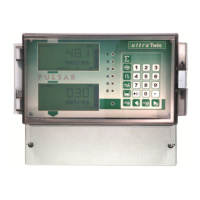Page 134
Device Fail
The digital inputs are used to indicate a ‘fail’ situation which effect devices,
which are connected to the relay outputs of the Twin, e.g. failure of a pump,
screen, valve, etc. This information is then used to initiate changes to the
Twins control regime to meet the demands of the situation.
Let us consider the example of an application using 2 pumps, each pump has
the capability to provide a signal indicating its ‘run’ status. Each pump is
connected and controlled by one of the Twin relay outputs, the duty and
setpoints have been programmed as detailed in Using the Relays, earlier in
this chapter. The signals providing details on the pumps ‘run status’ are
connected to the digital inputs as described in Chapter 2 Installation, and
the input Type P*372, 375, 378, 381, 384, 387, 390 is configured as
detailed in Input Type, earlier in this chapter.
Pump 1 is connected and programmed to operate on Relay 1
Pump 2 is connected and programmed to operate on Relay 2
Pump 1 Fail signal is connected to Digital Input 1
Pump 2 Fail signal is connected to Digital Input 2
Each digital input has to be assigned to the device relay output that it relates
to, this is determined by Assignment P*374, 377, 380, 383, 386, 389, 392.
In the case of our example Digital Input 1 will be assigned to Relay 1
(P*374 = 1) and Digital Input 2 will be assigned to Relay 2 (P*377 = 2).
When the level rises to the ON Setpoint of Relay 1, the relay will energise
and Pump 1 will ‘start’, in the normal manner. If the pump starts and runs
correctly no change of ‘run’ status will be seen on the digital input and the
pump(s) will be allowed to operate as programmed.
Should a pump fail, a change of ‘run’ status would be seen and a Device
Fail, condition would be detected on the corresponding digital input, this
will result in the relay for the ‘failed’ pump being de-energised and the
pump being switched OFF. The setpoints of the ‘failed’ pump will then be
passed to the second pump, which will take over to complete the pumping
operation.

